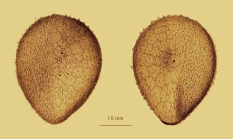WoRMS taxon details
Antrechinus drygalskii (Mortensen, 1905)
160779 (urn:lsid:marinespecies.org:taxname:160779)
accepted
Species
Urechinus drygalskii Mortensen, 1905 · unaccepted (transferred to Antrechinus)
marine, brackish, fresh, terrestrial
recent only
(of Urechinus drygalskii Mortensen, 1905) Mortensen, T. 1905. Some new species of Echinoidea. Videnskabelige Meddelelser fra den naturhistoriske Forening i Kjøbenhavn, Series 6 7, 241-243.
page(s): 241 [details]
page(s): 241 [details]
Type locality contained in Antarctica
, Note Near the Antarctic Continent; 3423 Meter....
type locality contained in Antarctica [details]
From editor or global species database
Type locality Near the Antarctic Continent; 3423 Meter. (German South- Polar Expedition.) [details]
Kroh, A.; Mooi, R. (2025). World Echinoidea Database. Antrechinus drygalskii (Mortensen, 1905). Accessed through: World Register of Marine Species at: https://www.marinespecies.org/aphia.php?p=taxdetails&id=160779 on 2025-07-05
Date
action
by
2005-06-30 11:30:47Z
created
db_admin
![]() The webpage text is licensed under a Creative Commons
Attribution 4.0 License
The webpage text is licensed under a Creative Commons
Attribution 4.0 License
Nomenclature
original description
(of Urechinus drygalskii Mortensen, 1905) Mortensen, T. 1905. Some new species of Echinoidea. Videnskabelige Meddelelser fra den naturhistoriske Forening i Kjøbenhavn, Series 6 7, 241-243.
page(s): 241 [details]
basis of record David, B., T. Choné, A. Festeau & C. de Ridder (2004). Antarctic Echinoids, an Interactive Database. Editions Universitaires Dijon. Cd Rom. (look up in IMIS) [details]
new combination reference Mooi, R. & David, B. 1996. Phylogenetic analysis of extreme morphologies: deep-sea holasteroid echinoids. Journal of Natural History 30, 913-953., available online at https://doi.org/10.1080/00222939600770501
page(s): 946 [details] Available for editors [request]
[request]
page(s): 241 [details]
basis of record David, B., T. Choné, A. Festeau & C. de Ridder (2004). Antarctic Echinoids, an Interactive Database. Editions Universitaires Dijon. Cd Rom. (look up in IMIS) [details]
new combination reference Mooi, R. & David, B. 1996. Phylogenetic analysis of extreme morphologies: deep-sea holasteroid echinoids. Journal of Natural History 30, 913-953., available online at https://doi.org/10.1080/00222939600770501
page(s): 946 [details] Available for editors
Other
context source (Deepsea)
Intergovernmental Oceanographic Commission (IOC) of UNESCO. The Ocean Biogeographic Information System (OBIS), available online at http://www.iobis.org/ [details]
 Present
Present  Present in aphia/obis/gbif/idigbio
Present in aphia/obis/gbif/idigbio  Inaccurate
Inaccurate  Introduced: alien
Introduced: alien  Containing type locality
Containing type locality
From editor or global species database
Original description Differs from U. naresianus in the configuration of the posterior end of the test; the periproct is just above the ambitus, rather sunken, the test produced beyond it, both above and below. There is a distinct subanal fasciole. Otherwise it agrees with U. naresianus in form and structure of the test. The globiferous pedicellariae afford a very distinct character; the valves end in a single long tooth, whereas in U. naresianus there are 9 long slender, gracefully curved teeth, surrounding a terminal opening. [details]Type locality Near the Antarctic Continent; 3423 Meter. (German South- Polar Expedition.) [details]

